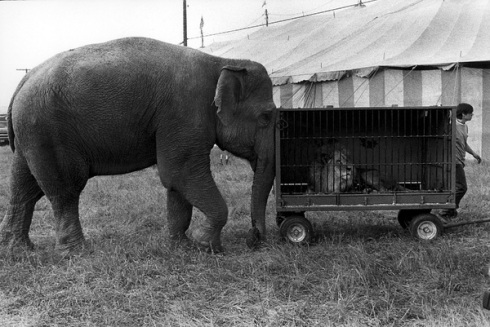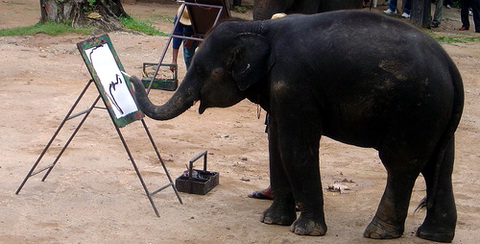…Ahmed came from the forests of Mount Marsabit in Kenya. The only elephant to be declared a living monument, President Kenyatta also provided him with a permanent guard against poachers. A loner and quite elusive, Ahmed was seldom seen and was known better by reputation than by sight. He died aged 55 in 1974. While Ahmed was alive it was thought that his tusks were of record size but after his death his tusks were found to weigh only 67,2 kilos each. This is still no mean size but is far from exceptional…(Read More:http://www.patrickmavros.com/store/index-c1-s6-i89.php)
…Thanks to his size, he was not swift, so the first spear throwers ran him down and caused fatal bleeding with jabs into the gut. They got him with poisoned arrows, with rock weighted spears that plunged into his neck. They drove him over cliffs, or ringed him with fire and roasted him.

—This photo by Richard Avedon is well-known for a reason. At the time, the contrast between the dirty elephants and the clean, elegant model was unheard of. Nowadays, this is not as jarring. Artists constantly push the boundaries, and society as a whole is not as conservative as we were in the 1950s.
What really makes the photograph unique is the textures: the rough elephant skin and the smooth fabric of the dress. There is also a contrast between the tones, which is further emphasized because the photo isn’t in color. The elephants are grey while the model in her dress is black and white.—Read More:http://rebeccaprowler.wordpress.com/2008/09/22/photo-review-dovima-with-elephants-by-richard-avedon/
But these were mere pinpricks. Even the ivory carving artisans of Egypt, five thousand years ago, did not much trouble him, though the Assyrians later obliterated him in Mesopotamia. A servant of Hannibal and the Romans, he was soon extinct in North Africa. But the continent is huge, and so is he.
The nineteenth century confronted him with a different challenge: he was suddenly out of scale, too big for the new world a-making. In fewer than a hundred years, five million tons of elephant flesh fell to hunters in the Congo alone. A quarter of a million tons of ivory from that region flowed into Sheffield ( knife handles), London ( biliard balls, piano keys), Dieppre ( paper cutters, book covers, combs, napkin rings),Bombay ( trinkets, toys, models), and Peking ( chessmen, puzzle boxes, curios).
His migration routes were cut by settlers. To cross East Africa, he ran a gantlet of rifle fire. Farms spread out over his feeding grounds. His giant feet and size made him easy to track. Muzzle-loaders once dazed or stunned him, but the new guns killed outright.

—Maybe Mr. Parsons saw himself as part of a line of men like Teddy Roosevelt there. It’s easy to convince yourself that you’re doing the right thing. Or maybe he’s just a spoiled millionaire who likes to shoot things. I can’t climb into his head to know for sure, nor can you.
There are some positive outcomes from the death of this elephant. The carcass of such a large herbivore can feed a dozen different species of predators and scavengers, and not just hyenas or flies, but humans as well. Certainly the villagers in the video seemed thrilled to butcher the carcass and distribute the meat.—Read More:http://nature.pagannewswirecollective.com/2011/05/12/the-death-of-an-elephant/
After this, irony. Men became alarmed. They protected him,controlled the shooting, established parks for his pleasure. His population soared; he poured into the parks, the bullets of angry farmers and frustrated big-game hunters snapping at his hind quarters. And now he is, willy-nilly, an ecological disaster. He eats out the inderstory of forests and lets in fire. During drought, he develops an appetite for giant baocomb trees: he eats the bark, the fruit, the leaves; n entire tree, weighing tons and perhaps a thousand years old, goes into hungry elephant stomachs in one night. Over thousands of square miles, he may leave almost every tree felled, shrubs ripped up, the ground gouged.

—http://nature.pagannewswirecollective.com/2011/05/12/the-death-of-an-elephant/—Jill Freedman photography.
So the men shoot him again. Now he becomes pet food and meat for hungry locals.Some of his kind will have a few more decades of freedom in a few scattered rain forests and parts of equatorial Sudan, but at great risk. He will survive in Africa, all right, but he remains a mute reminder that in great size there may be melancholy imperfections.

—The concept of Elephant painting in Thailand was actually perfected following trials undertaken at the Toledo Zoo in Ohio, U.S.A. using Asian elephants back in 1995.
Elephant painting in Thailand actually started in 1998 following the successful training of elephants at four different locations ar
ADDENDUM:
Hemingway, Hills Like White Elephants: …”Yes,” said the girl. “Everything tastes of licorice. Especially all the things you’ve waited so long for, like absinthe.”
“Oh, cut it out.”
“You started it,” the girl said. “I was being amused. I was having a fine time.”
“Well, let’s try and have a fine time.”
“All right. I was trying. I said the mountains looked like white elephants. Wasn’t that bright?”
“That was bright.”
“I wanted to try this new drink. That’s all we do, isn’t it–look at things and try new drinks?”
“I guess so.”
The girl looked across at the hills.
“They’re lovely hills,” she said. “They don’t really look like white elephants. I just meant the coloring of their skin through the trees.”
“Should we have another drink?”
“All right.” …





 COMMENTS
COMMENTS